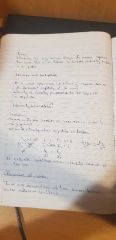![]()
![]()
![]()
Use LEFT and RIGHT arrow keys to navigate between flashcards;
Use UP and DOWN arrow keys to flip the card;
H to show hint;
A reads text to speech;
24 Cards in this Set
- Front
- Back
|
Uncertainty |
Largest reading - smallest reading divided by 2 |
|
|
Periodic time of a wave |
T(Periodic time)=1÷F(Frequency) |
|
|
The wave equation |
V(Velocity)=F(Frequency)× lamda(Wavelength) |
|
|
Intensity of a wave |
Intensity= power ÷ cross-sectional area |
|
|
Intensity and Amplitude |

|
|
|
Properties of fringes |
Lamda= ax ÷D |
|
|
Wavelength relates to the angle of diffraction by the formula: |
d sin thita =n×lamda |
|
|
For a source traveling at a speed Vs, emitting sound of speed v, observed frequency, Fo is given by: |
Fo=(Fs × V) ÷ (v+- Vs) |
|
|
Charge |
Current × time
Q=It |
|
|
Electrical work done |
Charge×Velocity |
|
|
Power |
Current × time |
|
|
Energy |
Current × Voltage × time OR Charge x Voltage |
|
|
Resistance |
Potential difference ÷ current |
|
|
Voltage |
Current × Resistance |
|
|
Energy 2 |
I^2 × R × t |
|
|
Energy 3 |
(V^2 × t) ÷ R |
|
|
Potential difference |
Work done ÷ charge |
|
|
Power 2 |
Potential difference × current |
|
|
Power 3 |
I^2 × Resistance |
|
|
Power 4 |
V^2 ÷ Resistance |
|
|
Resistance of a conductor |
R=p(resistivity) × l(lenght) |
|
|
Cross-sectional area |
Pie×d squared divided by 4 |
|
|
Extention |
0.5 × ke(spring constant)^2 |
|
|
Frequency |
1÷t(Time) |

